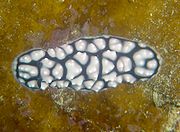Phyllidiella pustulosa
| Phyllidiella pustulosa | |
|---|---|

| |
| Phyllidiella pustulosa, Lipah Bay, Amed, Bali. | |
| Scientific classification | |
| Domain: | Eukaryota |
| Kingdom: | Animalia |
| Phylum: | Mollusca |
| Class: | Gastropoda |
| Order: | Nudibranchia |
| Superfamily: | Phyllidioidea |
| Family: | Phyllidiidae |
| Genus: | Phyllidiella |
| Species: | P. pustulosa
|
| Binomial name | |
| Phyllidiella pustulosa | |
| Synonyms[2] | |
| |
Phyllidiella pustulosa, the pustulose wart slug, pimpled phyllidiella, or pustulose phyllidiella, is a species of sea slug, a dorid nudibranch, in the family Phyllidiidae.[2][3]
Distribution
[edit]This species was described from specimens collected in Timor. It is one of the most common nudibranchs throughout the tropical Indo-West Pacific.[4][5] However, a study using DNA sequencing of the CO1 gene has shown that it is a species complex.[6]
Description
[edit]Although this nudibranch changes appearance as it grows, three median clusters of (usually) pink tubercles remain the same, except that they are amalgamated in juveniles and separated in large animals. These tubercles can range in color from pink to green to white. The intensity of the pink coloration and green-grey tones may possibly be related to diet, and the length of time since last feeding. Other distinguishing features are the pale pink edge of the mantle, the broad, triangular, black tipped oral tentacles and the rhinophoral clavus possessing 22 to 26 lamellae (in specimens greater than 35 mm).[7]
References
[edit]- ^ Cuvier, G.L.C.F., (1804). Memoire sur la Phyllidie et sur le Pleurobranch, deux nouveaux genres de mollusques de l'ordre des gasteropodes, et voisin des patelles les des oscabrions, dont l'autre porte une coquille caché. Annales du Muséum National d'Histoire Naturelle, Paris 5: 266-276.
- ^ a b Rosenberg, G.; Bouchet, P. (2012). Phyllidiella pustulosa. Accessed through: World Register of Marine Species on 2012-06-07
- ^ "Common Names List - Phyllidiella pustulosa". www.sealifebase.ca. Retrieved 12 January 2019.
- ^ Brunckhorst, D.J. (1993) The systematics and phylogeny of Phyllidiid Nudibranchs (Doridoidea). Records of the Australian Museum, Supplement 16: 1-107.
- ^ "Phyllidiella pustulosa & Pseudoceros imitatus". Rfbolland.com. 1993-04-03. Retrieved 2010-07-30.
- ^ Stoffels B.E., van der Meij S.E., Hoeksema B.W., van Alphen J., van Alen T., Meyers-Muñoz M.A., de Voogd N.J., Tuti Y., van der Velde G., (2016). Phylogenetic relationships within the Phyllidiidae (Opisthobranchia, Nudibranchia). ZooKeys, (605):1-35
- ^ Rudman, W.B., 1999 (September 12) Phyllidiella pustulosa (Cuvier, 1804). [In] Sea Slug Forum. Australian Museum, Sydney.
Further reading
[edit]- Litvaitis M.K. & Newman L.J., 2002. Color, Color Patterns and Mimicry.
- Newman, L.J.; Cannon, L.R.G.; Brunckhorst, D.J. 1994. A new flatworm (Platyhelminthes Polycladida) which mimics a Phyllidiid nudibranch (Mollusca, Nudibranchia). Zool. J. Linn. Soc. 110(1): 19-25. [publ. not seen by RFB]
- Newman, Leslie & Lester Cannon. 2003. Marine Flatworms: The World of Polyclads. vii + 112 pp. CSIRO Publishing.
- Rudman, W.B., 1998 (June 25). Mimicry - Phyllidiella, flatworms, Chromodoris [In] Sea Slug Forum.
- Rudman, W.B., 1999 (July 11). Comment on About Mimicry & flatworms by Christine. [Message in] Sea Slug Forum.
- Seifarth, W. 2004. Marine Flatworms of the World. http://www.rzuser.uni-heidelberg.de/~bu6/flatintr.htm]
External links
[edit]- Photos of Phyllidiella pustulosa on Sealife Collection

